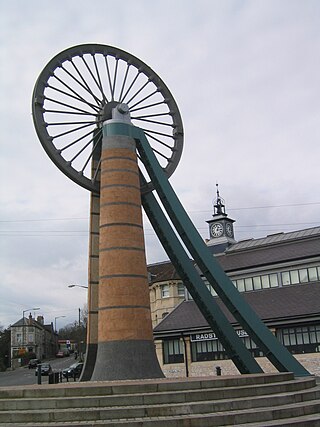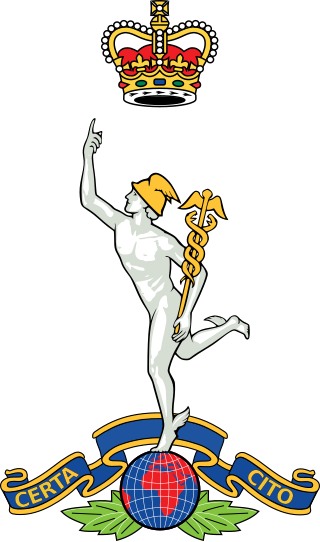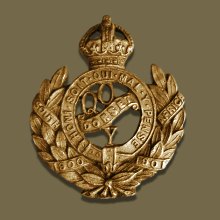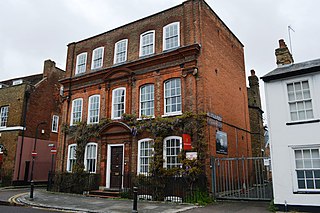
Wiltshire is a ceremonial county in South West England. It borders Gloucestershire to the north, Oxfordshire to the north-east, Berkshire to the east, Hampshire to the south-east, Dorset to the south, and Somerset to the west. The largest settlement is Swindon, and Trowbridge is the county town.

Bath and North East Somerset (B&NES) is a unitary authority district in Somerset, South West England. Bath and North East Somerset Council was created on 1 April 1996 following the abolition of the county of Avon. It is part of the ceremonial county of Somerset.

Radstock is a town and civil parish on the northern slope of the Mendip Hills in Somerset, England, about 9 miles (14 km) south-west of Bath and 8 miles (13 km) north-west of Frome. It is within the area of the unitary authority of Bath and North East Somerset. The Radstock built-up area had a population of 9,419 at the 2011 Census.

The Essex Yeomanry was a Reserve unit of the British Army that originated in 1797 as local Yeomanry Cavalry Troops in Essex. Reformed after the experience gained in the Second Boer War, it saw active service as cavalry in World War I and as artillery in World War II. Its lineage is maintained by 36 Signal Squadron, part of 71 (Yeomanry) Signal Regiment, Royal Corps of Signals.
The 43rd Infantry Brigade was a brigade of the British Army during the First and Second World Wars, and later, as 43 (Wessex) Brigade, a regional headquarters from 1985 to 2014.

39th (Skinners) Signal Regiment is an Army Reserve regiment in the Royal Corps of Signals in the British Army. The regiment forms part of 1 Signal Brigade, providing military communications for national operations. The Lynx badge is a reminder of the unit's connection with the Worshipful Company of Skinners.

The North Somerset Yeomanry was a part-time cavalry regiment of the British Army from 1798 to 1967. It maintained order in Somerset in the days before organised police forces, and supplied volunteers to fight in the Second Boer War. It served on the Western Front in the First World War. At the outbreak of the Second World War, it continued to operate in the mounted role and then as a specialist signals unit. Postwar it joined the Royal Armoured Corps and later became infantry. Its lineage today is maintained by 93 Squadron 39 (Skinners) Signal Regiment.

The Queen's Own Dorset Yeomanry was a yeomanry regiment of the British Army founded in 1794 as the Dorsetshire Regiment of Volunteer Yeomanry Cavalry in response to the growing threat of invasion during the Napoleonic wars. It gained its first royal association in 1833 as The Princess Victoria's Regiment of Dorset Yeomanry Cavalry, and its second, in 1843, as the Queen's Own Regiment of Dorset Yeomanry Cavalry.
The West Somerset Yeomanry was a Yeomanry regiment of the British Army. First raised in 1794, it participated in the Second Boer War and World War I before being converted to an artillery regiment. It served in World War II. Post-war it was gradually reduced in strength until the yeomanry lineage of the successor unit was discontinued on 9 November 1988.
The Royal North Devon Yeomanry was a Yeomanry regiment of the British Army. First raised in 1798, it participated in the Second Boer War and the First World War before being amalgamated with the Royal 1st Devon Yeomanry in 1920 to form the Royal Devon Yeomanry.

The Army Riding School was a military installation in Northumberland Road, Newcastle upon Tyne.

The Hunter Street drill hall is a military installation in Kirkcaldy, Scotland.

Yeomanry House is a military installation in Hertford. It is a Grade II* listed building.

The Allitsen Road drill hall is a former drill hall in St John's Wood, London.

The King's Road drill hall, sometimes referred to as the Old Cavalry Barracks, is a former military installation in King's Road in Bury St Edmunds. It is a Grade II listed building.

The Church Street drill hall is a former military installation in Brighton. It is a Grade II listed building.

The Friars' Walk drill hall is a former military installation in Stafford.

The Bear Street drill hall is a former military installation in Barnstaple, Devon. It is a Grade II listed building.

The 100th (Yeomanry) Regiment, Royal Artillery, formerly the National Reserve Headquarters, Royal Artillery is an Army Reserve administrative group of the Royal Artillery which oversees the recruitment and maintaining of specialist reserve units and personnel.

















